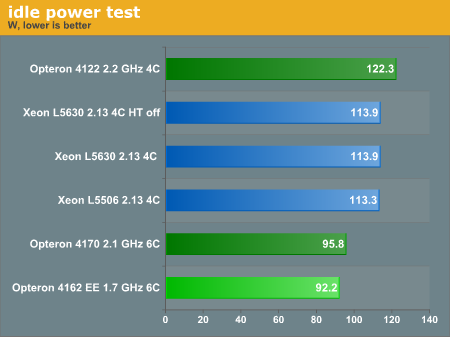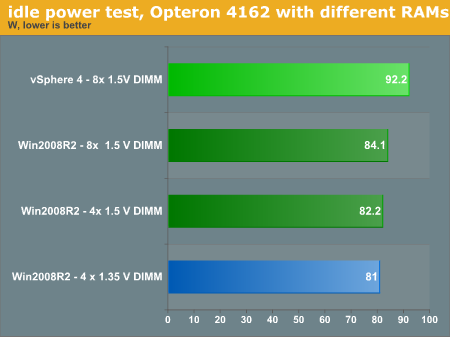Balancing Power, Price, and Performance in the Server CPU World
by Johan De Gelas on March 3, 2011 7:07 PM EST- Posted in
- IT Computing
- AMD
- Intel
- 1000W
- Xeon
- Opteron
- Cloud Computing
Idle Power Use
According to AMD, the key market for the low power "Lisbon" Opteron EE and HE is the cloud and web hosting space, where achieving the lowest power consumption possible is priority number one. So we measured the idle power draw running vSphere 4.1. The power policy selected was "Balanced".

Before we start analyzing the numbers, we must say that the Intel platform can probably go lower. It is possible to use a 450W PSU in this server, but we only had the 650W version available. This is an 80 Plus Silver certified PSU, so it should be at least 75% efficient at 10% load and 85% efficient at 20% load, and we're at around 15% load for this test. Although the idle numbers might be somewhat high for the Intel platform, our real-world power numbers on the next page shouldn't be off by more than a few watts, and those real-world numbers are the ones that count.
The AMD system came equipped with 16GB of low power DIMMs, but we did not use them for this test. The reason is that our vApusMark II takes 14GB per tile, and our standard test for dual socket systems is to use two tiles. Those two tiles need at least 28GB of RAM, plus some space for the ESX console and hypervisor (0.3 to 0.8 G RAM for the console + 0.5GB to 1GB for the vmkernel). We can show you what effect these low power DIMMs have at idle:

Even at idle, a hypervisor has more work to do than a supervisor OS like Windows 2008 R2. The result is a 10% higher power draw at idle. Each regular 1.5V DDR3 DIMM seems to take 0.5W at idle (2 Watt/4). If you replace four regular DDR3 DIMMs with four low power DIMMs at 1.35V, you can cut the RAM power draw in half. Low power DIMMs seem to save 0.3W per DIMM (1.2W / 4) at idle. So all in all, the RAM subsystems seems to draw little power at idle.
When the SQL server 2008 was running at 90% CPU load we measured a difference of 4.9W between four low power and 1.5V DDR-3 DIMMs. So low power DIMMs save you about 1.25W per 4 GB DIMM.










35 Comments
View All Comments
mino - Thursday, March 3, 2011 - link
While the Wh metric is useful for efficiency evaluation, it is pretty much useless for the exact scenario you mention in the conclusion - power-capped server hosting.Please add the load-power numbers to the article.
ppokorny - Sunday, March 6, 2011 - link
And if lower results are better, shouldn't the graphs be sorted so the shorter bars are on top?mfenn - Thursday, March 3, 2011 - link
People actually use the bezels on Dell servers?JohanAnandtech - Saturday, March 5, 2011 - link
Only for pretty pictures :-)Lord 666 - Thursday, March 3, 2011 - link
Trying to hold off on the 5600 purchase hoping that the 5700s are almost here.Any idea?
duploxxx - Friday, March 4, 2011 - link
ready to hold off until september - oktober?I assume you select an Intel server cpu by default as usual by IT?
Ben - Thursday, March 3, 2011 - link
I know that noise level is a bit of a joke for a "real" server, but I've had customers ask me about installing servers in environments that are less than ideal, where the noise level would be a factor in their decision (such as the corner of an office that is occupied).I would be interested in seeing noise levels from these units and possibly a future article focused on a couple units that don't sound like a 747 on takeoff.
jcandle - Friday, March 4, 2011 - link
I've experienced this as well. Primarily ones and twos of units as file and workgroup servers where towers would be ideal. Unfortunately, there are not many options when it comes to the storage. Those FC and SAS 16 and 24 bay RAIDs are virtually all designed for rack and put out their share of noise.While it doesn't occur often, some companies are requesting racks operate in the same room as workers; sometimes this has to do with large scientific equipment in the room, or other various lab requirements.
What I would also like to see in addition to noise levels (dB levels at various distances) like Ben request, is the the thermal load (BTU output of each unit). While some manufacturers give it out and it is often estimated, a real world assessment would be nice. Although I understand this would be difficult if you did not receive a dozen or more eval units; perhaps you have trick up your sleeve.
bobbozzo - Monday, March 7, 2011 - link
You can convert Watts to BTUs easily:http://www.google.com/search?q=watts+to+btu
ZL1Corvette - Thursday, March 3, 2011 - link
A 95W chip consuming it's full 95W, 24 hours a day, 365 days a year consumes 832.2 kWh a year. At the GE (http://www.csgnetwork.com/elecenergycalcs.html) average of $.1 per kWh, 832.3 kWh costs only $83.22/year. Going from a 95W chip to a 35W chip only saves $51.19/year. So going with the 4170HE instead of the 4122 costs you $74. You save $24.60 a year. You'd need to keep the chip about 3 years for it to pay for itself. You'll only save a fraction of that per year when only considering the chip consumption, which seems like a safe assumption in the spirit of this article where chips are swapped between the same server.I did not use the GE calculator, but it gives the same numbers. A TDP is the thermal output, but I think it's safe to assume that that number is a close representation of the power use of the CPU. Power in = Power out. The only power outs I can think of are the thermal power and the "data" power. I'd find it difficult to imagine the "data" power being significant, and I think that the data would be the same no matter which chip you use.